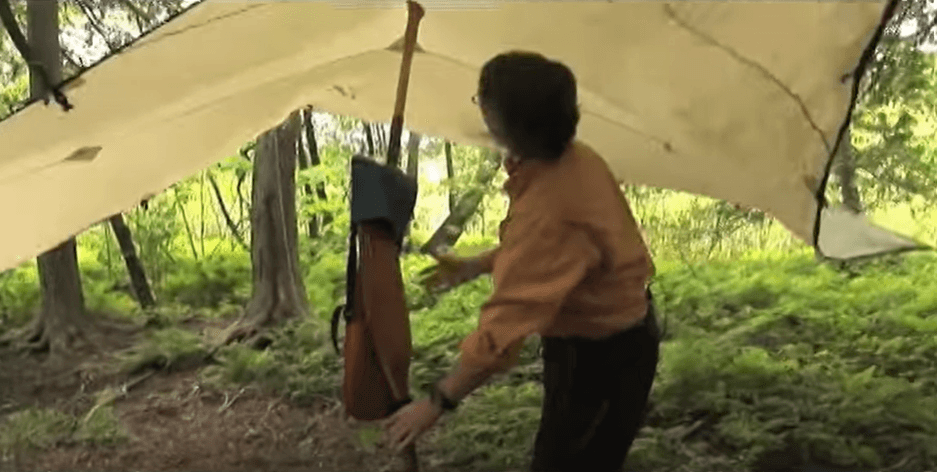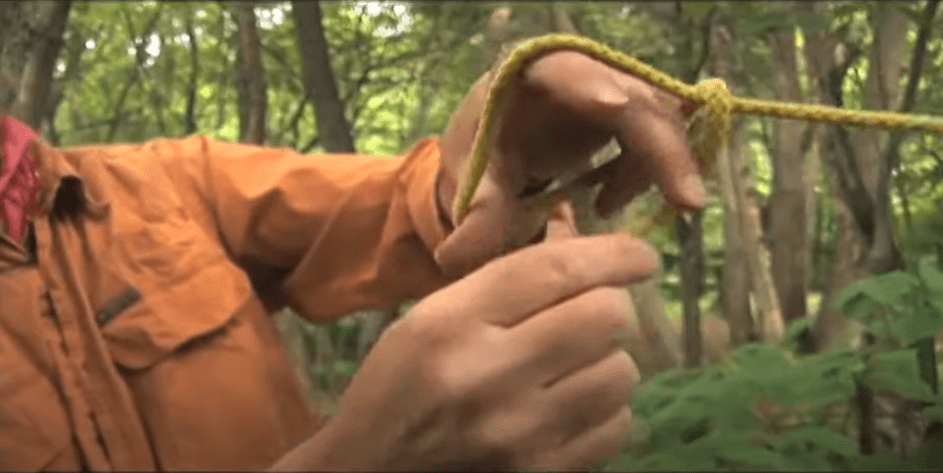Regarding Rain Tarps
The quality of your tarp and the skill of erecting one is more crucial on a trip than a tent. Why? It's all about group dynamics. During foul weather the worst thing for a group of paddlers to do is to cram tight inside a small tent to wait out the storm. It won't take long before even the best of friends begin to irritate one another. But under a tarp, with a warm fire going and a cup of tea brewing, things don't seem so bad - as long as you've put the tarp up correctly...
Finding Where to Put Up a Tarp
There's no specific trick to putting up a tarp. It's just that some campsites have a better arrangement of trees than others, making it easier. The perfect scenario is a tree for each of the four corners. More than likely, however, you'll have to unpack an extra length of rope and extend one or two corners to a nearby exposed root or alder bush.
Tarp Shape: Lean-To
The most common shape the tarp should be placed in is a "lean-to" style. This consists of having two ends placed up high, preferably attached to a rope strung between two trees, and the other two placed low to the ground, towards the prevailing winds. Make sure it's snug or the tarp will flop around in the wind and irritate you to no end throughout the night. I've attached small bungee cords on each corner grommet to help keep the ropes tight.
Keeping the Tarp Taught
A center pole also helps keep the tarp taunt. However, rather than searching all over for a tree limb to place in the center of the tarp, purchase a paddle strap - a device that allows two paddles to be attached together. Or better yet, throw a center line up over a high branch and "pull" the center up from the top rather then hold it up from the bottom.

Tarp Material
I started off with one of those big blue nylon-reinforced plastic tarps. It actually worked quite well, but was a real pain to carry. The material was extremely stiff and bulky. And the cheap corner grommets had a tendency to snap in heavy winds. Eventually I upgraded to a lightweight, polyurethane coated, rip-stop polyester tarp (you can get them in the even lighter nylon material). I love it. As soon as it rains, I erect the 10' x 12' (2.9m x 3.9m) tarp, build a small fire under it, and sit, relax and cook up a pot of tea or hot soup. There's nothing like it.
Knots for Putting Up a Tarp
Also, to keep things taught, you need to know two key knots:
Trucker's Hitch:
This is the ultimate combination of a knot and pulley system. It's a great way to rig rain tarps and tent guy ropes or just tighten up a cloths line. The best use, however, is to cinch down your canoe or kayak on top of your vehicle. First, tie off the rope onto the roof rack on one side of the load. Then, about three quarters along, twist the rope to form a loop and bring the loose end of the rope through the loop to form a second loop. Take note that the higher up you make the loop, the more powerful the hitch will be. Now, pass the rope around the other side of the roof rack and bring it back through the loop. Pull and hold down the grip by finishing off with a half hitch.

Taut-Line Hitch:
This hitch knot is generally used to tie down and adjust the tension on a tent rope when attached to a tent peg. The knot forms a loop that can be easily adjusted by sliding up and down the main line. Start by pulling the free end around the object and placing it under the standing end. Now, wrap the free end around the standing end. Wrap it a second time. To cinch it off, bring the free end back to the standing line, placing it on top of the rope and just in front of the first wrap. Now, make a half hitch by tucking the free end under the loop you formed and pull to tighten.
For those visual learners out there, here's a handy video with slow-motion of the knots.
Kevin Callan is the author of 15 books including "The New Trailside Cookbook" and "The Happy Camper." A regular keynote speaker at major North American canoeing and camping expos for over 20 years, he has received three National Magazine Awards and four film awards, including top award at the prestigious Waterwalker Film Festival. Callan lives in Peterborough, Ontario, birthplace of the modern-day canoe.
Related Articles
This question is from imsealin – they asked how long should a kayak be for sea kayaking, and can it be…
One of the considerations for deciding which type of material you want your kayak to be made from…
I've been busy lately rearranging my cooking essentials: the little tools that I can't do without. Of…
In 1971, I outfitted and guided three wealthy Chicago men--the least affluent of which earned a quarter…




